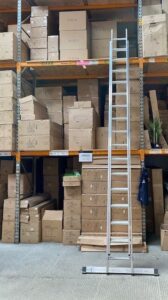Company fined after employee sustains serious injuries in fall from height
A North-East manufacturer of artificial trees, plants and flowers has been sentenced after an
 employee suffered serious injuries when he fell from height.
employee suffered serious injuries when he fell from height.
Newcastle Magistrates’ Court heard how a warehouse operative, was gathering products from shelf racking. The products were stored in boxes, unwrapped on pallets up to four bays high. Access to the racking was gained by using a ladder and then either dropping the items or carrying them down to the ground. During this work, the operative slipped from the ladder and fell approximately five metres, striking his head on a pallet as he fell, suffering a broken vertebra and a head injury.
An investigation by the Health and Safety Executive (HSE) found that Treelocate (Europe) Limited had failed to properly plan the work and failed to ensure there was safe access to the area and that measures were taken to prevent and/or mitigate a fall from height.
Treelocate (Europe) Limited of Belford Industrial Estate, Belford, Northumberland,
pleaded guilty to breaching Section 4(1) of the Work at Height Regulations 2005 and was fined £40,000 plus full costs of £1620.40 by Newcastle Magistrates Court.
After the hearing, HSE inspector Phil Chester said: “Treelocate (Europe) Ltd failed to suitably plan and carry out work at height in its warehouse to reduce the risk from working at height as far as is reasonably practicable. Ladders should not just be the go-to piece of equipment for working at height and suitable planning should be done in order to remove the risk where possible.”
- The Health and Safety Executive (HSE) is Britain’s national regulator for workplace health and safety. It aims to reduce work-related death, injury and ill health. It does so through research, information and advice, promoting training; new or revised regulations and codes of practice, and working with local authority partners by inspection, investigation and enforcement. www.hse.gov.uk
- More about the legislation referred to in this case can be found at: www.legislation.gov.uk/
- HSE news releases are available at http://press.hse.gov.uk
- Further information about health and safety during working at height can be found at: https://www.hse.gov.uk/pubns/indg401.pdf